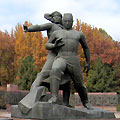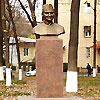Modern monuments of Tashkent
 Monuments of Mustakillik (Independence) Square
Monuments of Mustakillik (Independence) Square
On the largest square of the Republic of Uzbekistan sit the administrative headquarters of the Cabinet of Ministers and Senate. In the past few years Mustakillik Square, thanks to extensive reconstruction projects, has changed immensely, not only in style but in meaning. It remains the most important square in the country, a symbol of freedom and independence, and a place of worship, where the hopes and dreams of our generation are expressed.
 Courage Memorial
Courage Memorial
Among the large number of Tashkent monuments Courage Memorial deserves special attention. It is dedicated to the events that took place almost 50 years ago and left a deep trace in Tashkent's history. On the granite podium of the monuments stands a black labradorite cube. One of its sides contains the engraved inscription: April 26, 1966; on another side there is the engraved image of a clock-face whose hands show the time: 24 minutes past 5...
 Memorial to the Victims of Repression
Memorial to the Victims of Repression
The 1999 resolution led directly to the opening of the Museum of the Victims of Repression. The museum is located in the new Martyrs' Memorial Complex, which honors those who suffered under Russian and Soviet colonial rule. The blue-domed building contains exhibits on the recent history of the territory that now comprises Uzbekistan, ranging from the first Russian incursions against the Khanate of Khiva...
 Lal Bahadur Shastri monument
Lal Bahadur Shastri monument
Lal Bahadur Shastri (2 October 1904 - 11 January 1966) was the third (second, and acting, being Gulzarilal Nanda) Prime Minister of the Republic of India. After the declaration of ceasefire (the Indo-Pak war ended on 23 September 1965 with a United Nations-mandated ceasefire), Shastri and Pakistani President Muhammad Ayub Khan attended a summit in Tashkent, organized by Mr. Kosygin. On 10 January 1966, Shastri and Khan signed the Tashkent Declaration...

